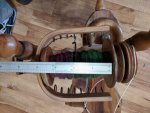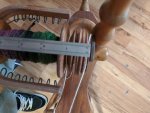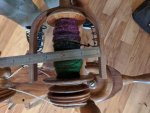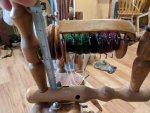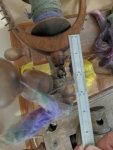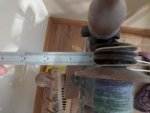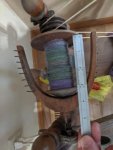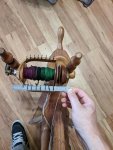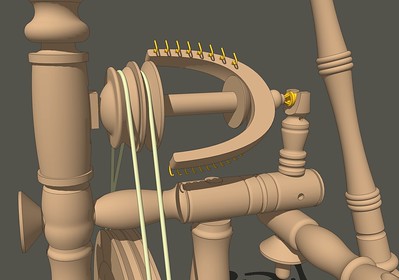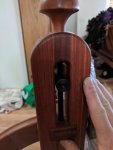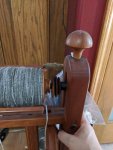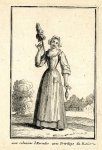I did catch that they are different diameters and modeled them according to the dimensions given but the one with the larger diameter in the groove is labeled as the Flyer Sheave. I wonder if the labels are reversed.
No that's correct - the flyer sheave is the one on the outside. Basically the bobbin is trapped between the flyer sheave and the front of the flyer. Usually the flyer sheave has an insert nut with a left handed thread so it doesn't unscrew itself while spinning. The bobbin, having a smaller sheave, has a higher gear ratio and thus wants to spin faster and pull the yarn onto itself. How quickly it does that is a combination of the ratio + the tension (which allows slippage).
On some more modern wheels the flyer sheave is press fit or otherwise attached so its easier to take on/off. On the older wheels I don't believe it was ever (or at least rarely) taken off and you'd instead spool the yarn off onto secondary bobbins and then either ply it or .. whatever.. from those.
I can actually spin something pretty close to thread on a drop spindle I've made out of some kindling with my pocket knife

The wheels are both trickier and easier in some ways, it certainly requires less focus once you get the hang of it and is arguably faster. The old walking wheels (spindle wheels) can actually spin finer and harder spun thread "easier" (for some value of easier). To get the same amount of twist into a yarn on a flyer wheel you pretty much have to put the yarn through twice (essentially re-spinning it). The wheel to whorl ratio largely defines the twist, the little flax wheel is a 16" wheel, the CPW is a 30" wheel the bobbin to flyer ratio on the CPW is 25:40 (so it has a smaller flyer sheave as well) - that wheel is HARD to spin on, only really makes super fine yarn and does so very very quickly (hence the "production wheel") - that wheel is from the 1860's.
I've never spun flax but understand it to be quite a bit more difficult than wool or alpaca.
Sometimes I'm lucky enough to have enough information to get by

A good chunk of the time neither of us have actually seen the thing we're trying to reproduce, or she only saw it in a class (grumble failure to take good notes and pictures grumble

) and is trying to describe it to me.
(looks up Norwegian tine) - interesting some of those look a lot like a shaker box. The robotics team sounds like fun, several of my coworkers have been heavily involved in the local ones but I've never really had the time.




